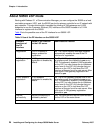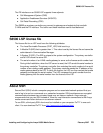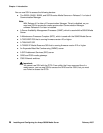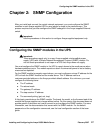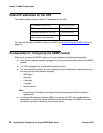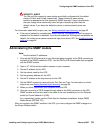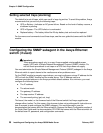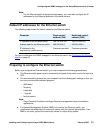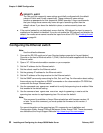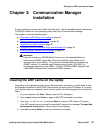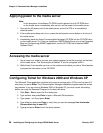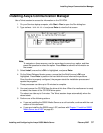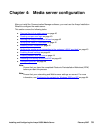
Chapter 2: SNMP Configuration
32 Installing and Configuring the Avaya S8500 Media Server February 2007
!
SECURITY ALERT:
!
SECURITY ALERT: The Get and Set community name strings are initially configured with the default
values of Public and Private, respectively. These community name strings
function as passwords for their respective SNMP operation. Avaya recommends
that you change these community name strings to something other than the
default values. If you leave the defaults in place, a serious security issue can
result.
● If the control network is not dedicated, ensure that the 162/udp port for input to server is
enabled and the default is disabled. If you do not enable the 162/udp port and disable the
default, the media server cannot receive the traps from either UPS. See Enabling firewall
settings on page 44.
Configuring the Ethernet switch
Note:
Note: Use the default addresses.
1. Connect the RS-232 serial port of your Services laptop computer to the port labeled
Console on the front of Ethernet switch 1 (CNA). Use the flat cable supplied with the Avaya
Ethernet switch.
2. Open a VT-100 terminal emulation session on your computer.
3. Set the IP address for the Ethernet switch.
4. Set the subnet mask for the Ethernet switch.
5. Set the gateway IP address for the Ethernet switch.
6. Set the IP address of the trap receiver for the Ethernet switch.
7. Set the SNMP community name string for Get, Set, and Trap. For information about setting
these values, see the section on SNMP commands on the documentation CD-ROM that
comes with the Avaya Ethernet switch.
8. Use the command set spantree enabled to verify that spanning tree is enabled. Note
that enabled is the default setting.
9. Use the command set spantree version rapid-spanning-tree to set the
spanning tree version to rapid-spanning-tree. Do not use the default.
Note:
Note: This command is available on Avaya Ethernet switches with firmware version 4.0
or later. To use this command, you must update the firmware to this version, if
necessary.
For more information on the spanning tree CLI commands, see Installation and
Configuration Guide, Avaya C360 and Reference Guide, Avaya C360. These documents
are available at the Avaya Support Web site http://www.avaya tha.com/support
.



